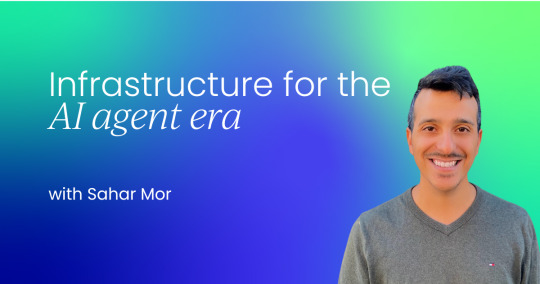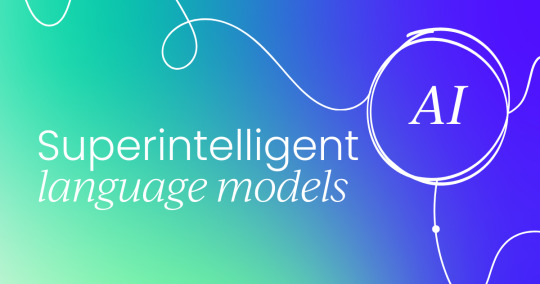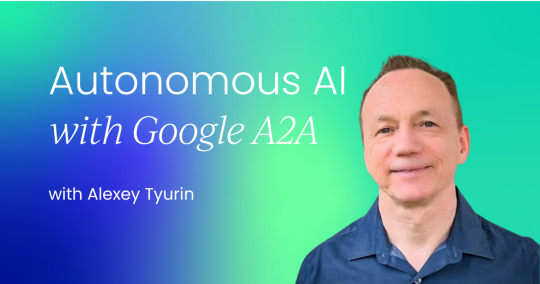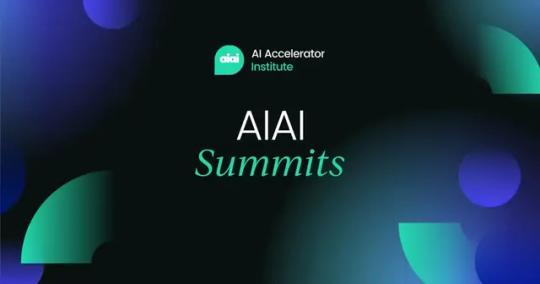#autonomous generated intelligence
Explore tagged Tumblr posts
Text

Neturbiz Enterprises - AI Innov7ions
Our mission is to provide details about AI-powered platforms across different technologies, each of which offer unique set of features. The AI industry encompasses a broad range of technologies designed to simulate human intelligence. These include machine learning, natural language processing, robotics, computer vision, and more. Companies and research institutions are continuously advancing AI capabilities, from creating sophisticated algorithms to developing powerful hardware. The AI industry, characterized by the development and deployment of artificial intelligence technologies, has a profound impact on our daily lives, reshaping various aspects of how we live, work, and interact.
#ai technology#Technology Revolution#Machine Learning#Content Generation#Complex Algorithms#Neural Networks#Human Creativity#Original Content#Healthcare#Finance#Entertainment#Medical Image Analysis#Drug Discovery#Ethical Concerns#Data Privacy#Artificial Intelligence#GANs#AudioGeneration#Creativity#Problem Solving#ai#autonomous#deepbrain#fliki#krater#podcast#stealthgpt#riverside#restream#murf
17 notes
·
View notes
Text

CAPTCHAs tech companies exploiting free labor to train AI vision for defense contractors military drones and autonomous weapons
#CAPTCHAs tech companies exploiting free labor to train AI vision for defense contractors military drones and autonomous weapons#captchas#tech companies#technology#tech#companies#fuck corporations#exploitation#exploitative#free labor#free labour#ai generated#ai art#ai artwork#ai girl#ai#a.i. generated#a.i. art#a.i.#artificial intelligence#military#army#navy#air force#fuck the military#anti military#military industrial complex#adf#adfa#australiandefenceforce
14 notes
·
View notes
Text
Nvidia’s Jensen Huang says AI agents are ‘a multi-trillion-dollar opportunity’ at last nights CES AI keynote. Let that “multi Trillion” sink in, because this global movement is just getting started.
#ces 2025#CES#ai chips#generative ai#AI#artificial intelligence#robotics#autonomous vehicles#autonomous aircraft#agentic ai#nvidia
2 notes
·
View notes
Text
CAP theorem in ML: Consistency vs. availability
New Post has been published on https://thedigitalinsider.com/cap-theorem-in-ml-consistency-vs-availability/
CAP theorem in ML: Consistency vs. availability

The CAP theorem has long been the unavoidable reality check for distributed database architects. However, as machine learning (ML) evolves from isolated model training to complex, distributed pipelines operating in real-time, ML engineers are discovering that these same fundamental constraints also apply to their systems. What was once considered primarily a database concern has become increasingly relevant in the AI engineering landscape.
Modern ML systems span multiple nodes, process terabytes of data, and increasingly need to make predictions with sub-second latency. In this distributed reality, the trade-offs between consistency, availability, and partition tolerance aren’t academic — they’re engineering decisions that directly impact model performance, user experience, and business outcomes.
This article explores how the CAP theorem manifests in AI/ML pipelines, examining specific components where these trade-offs become critical decision points. By understanding these constraints, ML engineers can make better architectural choices that align with their specific requirements rather than fighting against fundamental distributed systems limitations.
Quick recap: What is the CAP theorem?
The CAP theorem, formulated by Eric Brewer in 2000, states that in a distributed data system, you can guarantee at most two of these three properties simultaneously:
Consistency: Every read receives the most recent write or an error
Availability: Every request receives a non-error response (though not necessarily the most recent data)
Partition tolerance: The system continues to operate despite network failures between nodes
Traditional database examples illustrate these trade-offs clearly:
CA systems: Traditional relational databases like PostgreSQL prioritize consistency and availability but struggle when network partitions occur.
CP systems: Databases like HBase or MongoDB (in certain configurations) prioritize consistency over availability when partitions happen.
AP systems: Cassandra and DynamoDB favor availability and partition tolerance, adopting eventual consistency models.
What’s interesting is that these same trade-offs don’t just apply to databases — they’re increasingly critical considerations in distributed ML systems, from data pipelines to model serving infrastructure.
The great web rebuild: Infrastructure for the AI agent era
AI agents require rethinking trust, authentication, and security—see how Agent Passports and new protocols will redefine online interactions.

Where the CAP theorem shows up in ML pipelines
Data ingestion and processing
The first stage where CAP trade-offs appear is in data collection and processing pipelines:
Stream processing (AP bias): Real-time data pipelines using Kafka, Kinesis, or Pulsar prioritize availability and partition tolerance. They’ll continue accepting events during network issues, but may process them out of order or duplicate them, creating consistency challenges for downstream ML systems.
Batch processing (CP bias): Traditional ETL jobs using Spark, Airflow, or similar tools prioritize consistency — each batch represents a coherent snapshot of data at processing time. However, they sacrifice availability by processing data in discrete windows rather than continuously.
This fundamental tension explains why Lambda and Kappa architectures emerged — they’re attempts to balance these CAP trade-offs by combining stream and batch approaches.
Feature Stores
Feature stores sit at the heart of modern ML systems, and they face particularly acute CAP theorem challenges.
Training-serving skew: One of the core features of feature stores is ensuring consistency between training and serving environments. However, achieving this while maintaining high availability during network partitions is extraordinarily difficult.
Consider a global feature store serving multiple regions: Do you prioritize consistency by ensuring all features are identical across regions (risking unavailability during network issues)? Or do you favor availability by allowing regions to diverge temporarily (risking inconsistent predictions)?
Model training
Distributed training introduces another domain where CAP trade-offs become evident:
Synchronous SGD (CP bias): Frameworks like distributed TensorFlow with synchronous updates prioritize consistency of parameters across workers, but can become unavailable if some workers slow down or disconnect.
Asynchronous SGD (AP bias): Allows training to continue even when some workers are unavailable but sacrifices parameter consistency, potentially affecting convergence.
Federated learning: Perhaps the clearest example of CAP in training — heavily favors partition tolerance (devices come and go) and availability (training continues regardless) at the expense of global model consistency.
Model serving
When deploying models to production, CAP trade-offs directly impact user experience:
Hot deployments vs. consistency: Rolling updates to models can lead to inconsistent predictions during deployment windows — some requests hit the old model, some the new one.
A/B testing: How do you ensure users consistently see the same model variant? This becomes a classic consistency challenge in distributed serving.
Model versioning: Immediate rollbacks vs. ensuring all servers have the exact same model version is a clear availability-consistency tension.
Superintelligent language models: A new era of artificial cognition
The rise of large language models (LLMs) is pushing the boundaries of AI, sparking new debates on the future and ethics of artificial general intelligence.

Case studies: CAP trade-offs in production ML systems
Real-time recommendation systems (AP bias)
E-commerce and content platforms typically favor availability and partition tolerance in their recommendation systems. If the recommendation service is momentarily unable to access the latest user interaction data due to network issues, most businesses would rather serve slightly outdated recommendations than no recommendations at all.
Netflix, for example, has explicitly designed its recommendation architecture to degrade gracefully, falling back to increasingly generic recommendations rather than failing if personalization data is unavailable.
Healthcare diagnostic systems (CP bias)
In contrast, ML systems for healthcare diagnostics typically prioritize consistency over availability. Medical diagnostic systems can’t afford to make predictions based on potentially outdated information.
A healthcare ML system might refuse to generate predictions rather than risk inconsistent results when some data sources are unavailable — a clear CP choice prioritizing safety over availability.
Edge ML for IoT devices (AP bias)
IoT deployments with on-device inference must handle frequent network partitions as devices move in and out of connectivity. These systems typically adopt AP strategies:
Locally cached models that operate independently
Asynchronous model updates when connectivity is available
Local data collection with eventual consistency when syncing to the cloud
Google’s Live Transcribe for hearing impairment uses this approach — the speech recognition model runs entirely on-device, prioritizing availability even when disconnected, with model updates happening eventually when connectivity is restored.
Strategies to balance CAP in ML systems
Given these constraints, how can ML engineers build systems that best navigate CAP trade-offs?
Graceful degradation
Design ML systems that can operate at varying levels of capability depending on data freshness and availability:
Fall back to simpler models when real-time features are unavailable
Use confidence scores to adjust prediction behavior based on data completeness
Implement tiered timeout policies for feature lookups
DoorDash’s ML platform, for example, incorporates multiple fallback layers for their delivery time prediction models — from a fully-featured real-time model to progressively simpler models based on what data is available within strict latency budgets.
Hybrid architectures
Combine approaches that make different CAP trade-offs:
Lambda architecture: Use batch processing (CP) for correctness and stream processing (AP) for recency
Feature store tiering: Store consistency-critical features differently from availability-critical ones
Materialized views: Pre-compute and cache certain feature combinations to improve availability without sacrificing consistency
Uber’s Michelangelo platform exemplifies this approach, maintaining both real-time and batch paths for feature generation and model serving.
Consistency-aware training
Build consistency challenges directly into the training process:
Train with artificially delayed or missing features to make models robust to these conditions
Use data augmentation to simulate feature inconsistency scenarios
Incorporate timestamp information as explicit model inputs
Facebook’s recommendation systems are trained with awareness of feature staleness, allowing the models to adjust predictions based on the freshness of available signals.
Intelligent caching with TTLs
Implement caching policies that explicitly acknowledge the consistency-availability trade-off:
Use time-to-live (TTL) values based on feature volatility
Implement semantic caching that understands which features can tolerate staleness
Adjust cache policies dynamically based on system conditions
How to build autonomous AI agent with Google A2A protocol
How to build autonomous AI agent with Google A2A protocol, Google Agent Development Kit (ADK), Llama Prompt Guard 2, Gemma 3, and Gemini 2.0 Flash.

Design principles for CAP-aware ML systems
Understand your critical path
Not all parts of your ML system have the same CAP requirements:
Map your ML pipeline components and identify where consistency matters most vs. where availability is crucial
Distinguish between features that genuinely impact predictions and those that are marginal
Quantify the impact of staleness or unavailability for different data sources
Align with business requirements
The right CAP trade-offs depend entirely on your specific use case:
Revenue impact of unavailability: If ML system downtime directly impacts revenue (e.g., payment fraud detection), you might prioritize availability
Cost of inconsistency: If inconsistent predictions could cause safety issues or compliance violations, consistency might take precedence
User expectations: Some applications (like social media) can tolerate inconsistency better than others (like banking)
Monitor and observe
Build observability that helps you understand CAP trade-offs in production:
Track feature freshness and availability as explicit metrics
Measure prediction consistency across system components
Monitor how often fallbacks are triggered and their impact
Wondering where we’re headed next?
Our in-person event calendar is packed with opportunities to connect, learn, and collaborate with peers and industry leaders. Check out where we’ll be and join us on the road.
AI Accelerator Institute | Summit calendar
Unite with applied AI’s builders & execs. Join Generative AI Summit, Agentic AI Summit, LLMOps Summit & Chief AI Officer Summit in a city near you.

#agent#Agentic AI#agents#ai#ai agent#AI Engineering#ai summit#AI/ML#amp#applications#applied AI#approach#architecture#Article#Articles#artificial#Artificial General Intelligence#authentication#autonomous#autonomous ai#awareness#banking#Behavior#Bias#budgets#Business#cache#Calendar#Case Studies#challenge
0 notes
Text
Emerging Energy Technologies: Data, AI, and Digital Solutions Reshaping the Industry
The energy industry is undergoing a revolutionary transformation, driven by cutting-edge technologies that are reshaping how energy operations are managed. With advancements like autonomous robotics, AI, and real-time data analytics, these innovations are solving key challenges and setting new benchmarks for efficiency and sustainability.
Key Developments in Emerging Energy Technologies
Energy Digital Transformation is more than just a trend — it’s a necessity. The integration of advanced tools and strategies is enabling energy companies to overcome barriers, optimize processes, and unlock new possibilities for growth and sustainability. Below, we outline key developments that are shaping this transformation.
Learn more on Future of Oil & Gas in 2025: Key trends
1. Automation and Real-Time Insights
Advanced automation and real-time data solutions are transforming energy operations. These innovations are making operations safer, faster, and more efficient.
Autonomous Robotics: Tools like ANYbotics are automating inspections in hazardous environments, reducing the risk of human error.
Edge Computing: Solutions like IOTech (AcuNow) enable faster and more responsive decision-making by processing data at the edge.
Key Statistics:
The automation adoption in the energy sector is projected to increase by 15–20% in 2025.
Autonomous robotics in hazardous environments is expected to reduce inspection time by 30%.
2. Harnessing the Power of Data
Energy Data Analytics is becoming increasingly critical for energy companies. By harnessing real-time data, companies can optimize performance and make better decisions.
Digital Twin Technology: The KDI Kognitwin integrates with AcuSeven to offer predictive maintenance and improve operational efficiency.
Data Analytics: Platforms like Databricks, AcuPrism enable real-time data analysis to drive better decision-making.
Key Statistics:
Energy sector spending on data analytics is expected to grow by 10–15% annually over the next five years.
The implementation of digital twins is expected to improve maintenance efficiency by 20–25%.
Watch the Webinar Recording
To explore these innovations in more detail, watch the recorded version of SYNERGY FOR ENERGY. Gain exclusive insights into how these trends and technologies are shaping the future of the energy sector.
Click here to watch
3. AI-Driven Energy Optimization
Artificial Intelligence is transforming how energy companies manage operations in the Energy Sector, from predictive maintenance to forecasting. AI is predicted to play a central role in optimizing energy usage and reducing costs.
Generative AI: AI-driven applications enhance forecasting, predictive maintenance, and optimization of energy consumption.
Energy Efficiency Tools: AI-based tools help organizations achieve sustainability goals by reducing waste and optimizing consumption.
Key Statistics:
AI-driven solutions are expected to account for 25–30% of energy management by 2025.
Energy efficiency tools can reduce consumption by 15% across industries.
4. Streamlining Digital Transformation
The shift to digital tools is vital for staying competitive in the fast-evolving energy industry. Digital transformation is helping companies modernize legacy systems and enhance data management.
Custom Digital Applications: Acuvate’s solutions streamline the deployment of digital tools to enhance operational efficiency.
Modernizing Legacy Systems: Solutions like Microsoft Fabric and AcuWeave simplify the migration from outdated systems, improving scalability and performance.
Read more about Top 4 Emerging Technologies Shaping Digital Transformation in 2025
Key Statistics:
Digital adoption in the energy sector is expected to increase by 20% by 2025.
The use of Microsoft Fabric has reduced migration costs by 20–30%.
Looking Ahead: Key Trends for 2025
As we are in 2025, several key trends will further influence the energy sector:
Increased Focus on Renewable Energy: The International Energy Agency predicts that over a third of global electricity will come from renewable sources.
AI’s Growing Demand: The computational needs of AI will significantly drive electricity demand, necessitating a focus on sustainable energy sources.
Nuclear Energy Renaissance: A renewed societal acceptance of nuclear power as part of the energy transition is gaining momentum.
Continued R&D Investment: Ongoing investments in research and development will spur innovation across clean energy technologies.
Conclusion
The ongoing transformation within the energy sector underscores the critical role of innovation in driving efficiency and sustainability. As automation, data analytics, AI, and digital transformation continue to evolve, they will collectively shape a more resilient and environmentally friendly energy landscape. Engaging with these advancements through initiatives like webinars and industry reports will provide valuable insights into navigating this dynamic environment effectively.
For More Insightful Webinars
For more insightful webinars like SYNERGY FOR ENERGY, visit our website. We host a variety of sessions designed to provide in-depth insights into the latest innovations shaping industries worldwide. Stay informed and explore the future of technology and business.
Check out our upcoming webinars here.
#autonomous robots#Advanced automation#real-time data solutions#data analytics#generative ai#Artificial Intelligence#AI-driven applications#Microsoft Fabric#Digital transformation#predictive maintenance
0 notes
Text
Stay ahead with the latest trends in AI agents. Learn how these autonomous tools are reshaping industries, from finance to healthcare.

Discover how AI agents are transforming industries with intelligent automation, boosting efficiency, and enabling smarter decision-making in 2025 and beyond.
#AI agents#autonomous AI agents#intelligent agents#AI automation#AI-powered tools#artificial intelligence agents#AI agents in business#AI customer service agents#AI agents for startups#AI automation for enterprises#AI virtual assistants#workflow automation#generative AI#AI trends 2025#future of AI#machine learning agents#conversational AI#AI task automation#how AI agents work#benefits of AI agents#best AI agents for productivity#using AI agents in business#AI agents for process automation#top AI agents tools
1 note
·
View note
Text
The Future is Now: 5G and Next-Generation Connectivity Powering Smart Innovation.
Sanjay Kumar Mohindroo Sanjay Kumar Mohindroo. skm.stayingalive.in Explore how 5G networks are transforming IoT, smart cities, autonomous vehicles, and AR/VR experiences in this inspiring, in-depth guide that ignites conversation and fuels curiosity. Embracing a New Connectivity Era Igniting Curiosity and Inspiring Change The future is bright with 5G networks that spark new ideas and build…

View On WordPress
#5G Connectivity#AI-powered Connectivity#AR/VR Experiences#Autonomous Vehicles#Connected Ecosystems#Data-Driven Innovation#digital transformation#Edge Computing#Future Technology#Future-Ready Tech#High-Speed Internet#Immersive Experiences#Innovation in Telecommunications#Intelligent Infrastructure#Internet Of Things#IoT#Modern Connectivity Solutions#News#Next-Generation Networks#Sanjay Kumar Mohindroo#Seamless Communication#Smart Cities#Smart Mobility#Ultra-Fast Networks
0 notes
Text
🌟 Dive into the Future of AI! 🌟 Curious about the difference between Agentic AI and AI Agents? Our latest article breaks it down for you! From enhancing business efficiency to paving the way for Artificial General Intelligence, these technologies are changing the game. Read more to stay informed and ahead in the tech landscape! 🚀 [Insert Link to Article] #AI #AgenticAI #AIAgents #ArtificialIntelligence #TechTrends #Innovation #DigitalTransformation
#Agentic AI#AI Agents#AI in Business#Artificial General Intelligence (AGI)#Artificial Intelligence#Autonomous Systems#Digital Transformation#Future of AI#Machine Learning#Technology Trends
0 notes
Text
10 Cutting-Edge Technology Trends Shaping 2025
In today’s rapidly evolving digital landscape, staying ahead means embracing transformative innovations that redefine every aspect of our lives. As we approach 2025, industries across the board are being revolutionized by a wave of advancements. The future is being molded by 10 Cutting-Edge Technology that not only streamline processes but also inspire creativity, enhance connectivity, and drive…
#10 Cutting-Edge Technology#2025 Tech Trends#5G#6G#AR#Artificial Intelligence#Autonomous Vehicles#Biotechnology#Blockchain#Cybersecurity#Decentralized Finance#Digital Transformation#Extended Reality#Future Technology#Green Technologies#Health Tech#Innovation#Internet of Things#IoT#Machine Learning#Next Generation Connectivity#Quantum Computing#Smart Transportation#Sustainable Energy#VR
0 notes
Text
youtube
Discover the Power of Fliki AI for Creators!
Fliki AI is a cutting-edge tool revolutionizing the AI industry by offering a seamless platform for generating high-quality content efficiently. Important Note: This video contains Affiliate links, where if someone navigates to them, there is a possibility that a commission will be paid to me by the affiliate.
Fliki AI:

With the increasing demand for AI-generated content, Fliki AI stands out as a game-changer in the field. Generating AI content efficiently is crucial for businesses and content creators looking to streamline their workflow and produce engaging articles quickly.
Fliki AI simplifies the content creation process, saving time and resources while maintaining top-notch quality. By using Fliki AI, you can unlock a plethora of benefits such as improved productivity, enhanced creativity, and access to a wide range of article ideas tailored to your specific needs. Stay tuned to discover how Fliki AI can elevate your content creation!
#aicontentgeneration #artificialintelligencerevolution
#fliki ai#neturbiz#enterprises#generative AI#Technology Revolution#Machine Learning#Content Generation#Complex Algorithms#Neural Networks#Human Creativity#Original Content#Healthcare#Finance#Entertainment#Medical Image Analysis#Drug Discovery#Ethical Concerns#Data Privacy#Artificial Intelligence#GANs#Audio Generation#Creativity#Problem Solving#ai#autonomous#text to video#text to speech#ai scene generator#ai automated editing#innovations
0 notes
Text
The Magic of AI!
Minimax AI - Text to Video Generator (For now it is Free to Use!).
The Text to Video is amazingly simple to use and from what I've seen so far it is unlimited.
There are several other Videos to explore and use their video prompts to generate your very own videos. - Pretty Awesome!

Are you absolutely certain that you want to miss out on the AI Trend?
#minimax ai#Generative AI#Technology Revolution#Machine Learning#Content Generation#Complex Algorithms#Neural Networks#Human Creativity#Original Content#Healthcare#Finance#Entertainment#Medical Image Analysis#Drug Discovery#Ethical Concerns#Data Privacy#Artificial Intelligence#GANs#AudioGeneration#Creativity#Problem Solving#ai#autonomous#deepbrain#fliki#krater#podcast#stealthgpt#riverside#restream
0 notes
Text

Neturbiz Enterprises YouTube Channel - AI - Innovations
Our mission is to provide details about AI-powered platforms across different technologies, each of which offer unique set of features. The AI industry encompasses a broad range of technologies designed to simulate human intelligence.
These include machine learning, natural language processing, robotics, computer vision, and more. Companies and research institutions are continuously advancing AI capabilities, from creating sophisticated algorithms to developing powerful hardware.
The AI industry, characterized by the development and deployment of artificial intelligence technologies, has a profound impact on our daily lives, reshaping various aspects of how we live, work, and interact. The AI industry presents numerous opportunities for affiliate marketers to promote cutting-edge tools and services. Each Platform may offer different commission rates.
#artificial intelligence #generative ai
#Generative AI#Technology Revolution#Machine Learning#Content Generation#Complex Algorithms#Neural Networks#Human Creativity#Original Content#Healthcare#Finance#Entertainment#Medical Image Analysis#Drug Discovery#Ethical Concerns#Data Privacy#Artificial Intelligence#GANs#AudioGeneration#Creativity#Problem Solving#ai#autonomous#deepbrain#fliki#krater#podcast#stealthgpt#riverside#restream#murf
0 notes
Text
youtube
STOP Using Fake Human Faces in AI
#GenerativeAI#GANs (Generative Adversarial Networks)#VAEs (Variational Autoencoders)#Artificial Intelligence#Machine Learning#Deep Learning#Neural Networks#AI Applications#CreativeAI#Natural Language Generation (NLG)#Image Synthesis#Text Generation#Computer Vision#Deepfake Technology#AI Art#Generative Design#Autonomous Systems#ContentCreation#Transfer Learning#Reinforcement Learning#Creative Coding#AI Innovation#TDM#health#healthcare#bootcamp#llm#youtube#branding#animation
1 note
·
View note
Text
We Need to Regulate and Defend Ourselves From Rogue Autonomous AI and AGI Systems
0 notes
Text
Amazing Architecture: Generative AI Creates Eco-Friendly Buildings By Daniel Reitberg
A powerful new tool called generative AI is making the future of building look greener. By looking at things like how much energy a building uses and what resources it uses, these AI models are changing the way sustainable buildings are designed. In this way, they can not only make buildings that are good for the environment, but also ones that are new and look good.
Imagine a building that gets all of its light from the sun during the day, so it doesn't need any extra lighting. Generative AI can make buildings that get the most sunlight, which means they use less power. These models can also look at wind patterns to help make natural air systems that are even better for the environment.
The cool thing about generative AI is that it can look into a huge design space. Traditional methods may limit the choices that can be made, but AI can create a huge number of options, some of which may be breakthroughs that were not expected. This makes long-term answers possible that may not have been thought of before.
Remember that generative AI isn't here to take the place of builders. Instead, it gives them the freedom to explore new design ideas and make buildings that are useful and good for the environment. AI can give architects more choices, and they can then use their knowledge to narrow down the choices and pick the most environmentally friendly and physically pleasing design for a given project. Generate AI is a strong tool that could change how we plan and construct a more environmentally friendly future.
#artificial intelligence#machine learning#deep learning#technology#robotics#autonomous vehicles#robots#collaborative robots#business#generative ai#architecture#buildings#construction industry
0 notes
Text
Zendesk Unveils the Industry’s Most Complete Service Solution for the Ai Era
At its Relate global conference, Zendesk announced the world’s most complete service solution for the AI era. With support volumes projected to increase five-fold over the next few years, companies need a system that continuously learns and improves as the volume of interactions increases. To help businesses deliver exceptional service, Zendesk is launching autonomous AI agents, workflow…

View On WordPress
#Advanced Tools#Agent Copilot#AI agents#AI Compliance#AI integration#AI Monitoring#AI Reporting#AI Service Solutions#AI-Powered Service#Alicia Monroe#Autonomous AI Agents#business growth#competitive advantage#customer experience#Customer Interaction#Customer Loyalty#Customer Retention#Customer Satisfaction#customization#CX Leaders#generative AI#Ingram Micro#Intelligent Automation#Knowledge Bases#María de la Plaza#Personalized Intents#Predictive Tools#Proactive Guide#Quality Assurance#Revenue Growth
0 notes